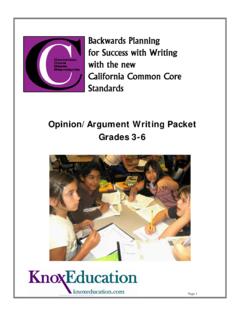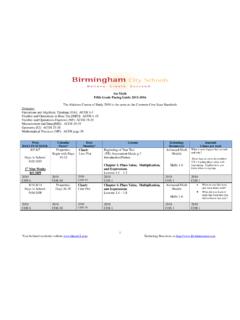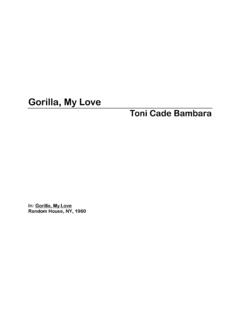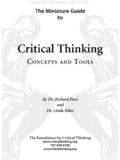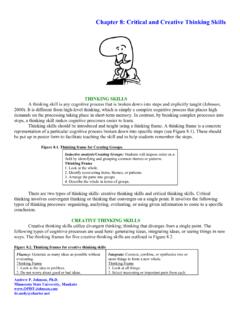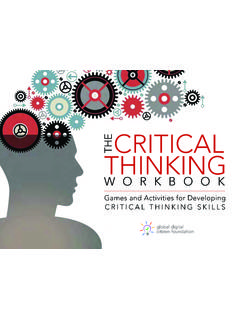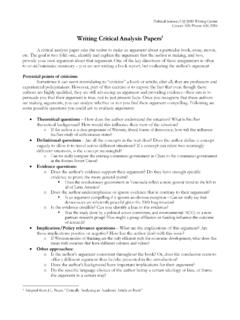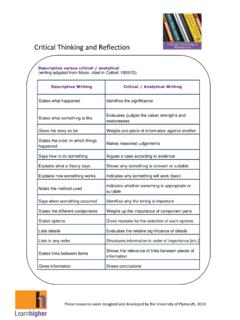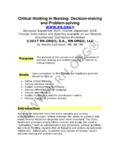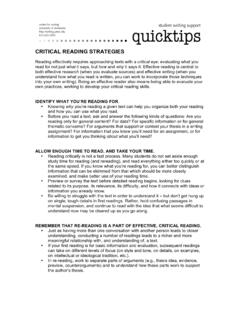Transcription of 501 Critical Reading Questions - Birmingham City Schools
1 501 Critical Reading Questions501 Critical Reading QuestionsNEW YORK Copyright 2004 LearningExpress, rights reserved under International and Pan-American Copyright Conventions. Published in the United States by LearningExpress, LLC, New of Congress Cataloging-in-Publication Data:501 Critical Reading Questions . 1st 1-57685-510-4 (pbk. : alk. paper)1. Reading (Secondary) Examinations, Questions , etc. 2. Reading comprehension Examinations, Questions , etc. 3. Readers (Secondary) I. Title: Five hundred onecritical Reading Questions . II. Title: Five hundred and one Critical Reading LearningExpress (Organization) '07'12 dc222004001114 Printed in the United States of America9 8 7 6 5 4 3 2 1 First EditionISBN 1-57685-510-4 For more information or to place an order, contact LearningExpress at:55 Broadway8th FloorNew York, NY 10006Or visit us LearningExpress Skill Builder in Focus Writing Teamiscomprised of experts in test preparation, as well as educators and teachers who specialize in language Skill Builder in Focus Writing TeamMarco A.
2 AnnunziataFreelance WriterNew York, New YorkElizabeth CheslaEnglish InstructorLanguage Arts ExpertHarleysville, PennsylvaniaBrigit DermottFreelance WriterEnglish Tutor, New York CaresNew York, New YorkMargaret MuirheadFreelance WriterArlington, MassachusettsPatricia MulraneFreelance WriterNew York, New YorkLauren StarkeyFreelance Reference WriterEssex, VermontC ReedTest Preparation ExpertBurbank, CaliforniaIntroductionix1 Popular Culture12 History and Politics273 Arts and Humanities594 Health and Medicine875 Literature and Literary Criticism1216 Music1557 Science and Nature1818 Sports and Leisure2119 Social Studies245 Source Materials267 ContentsviiWhy Should I Use this Book? Schools and employers know that students and workers who reason criti-cally about what they read are better students and more valuable employ-ees.
3 That is why standardized tests almost invariably include a readingcomprehension book is designed to help you be a more successful Critical are probably most interested in performing well on a standardized testsuch as the SAT, ACT, or a vocational or professional exam. By Reading andworking through 501 Critical Reading Questionsyou will become much moreproficient at answering the multiple-choice Questions found on those benefits you gain from this practice and from your conscious attentionto Critical reasoning skills will extend far beyond any exam and into allaspects of your life. Reading will become a much more rewarding andenjoyable experience, and your life will be richer for Is in this Book?Each of the chapters in this book focuses on a different subject matter, soregardless of the exact exam you need to prepare for, there will be contentsimilar to material you will face on your exam.
4 However, it s important thatIntroductionixyou practice with all the passages, not just the ones in your areas of inter-est. Sometimes unfamiliar subjects can teach you the most valuable lessonsabout Critical chapter contains three short Reading passages, similar to the onesfound on many exams, including the SAT. There are also six longer pas-sages, two of which are paired for purposes of in Chapter One deal with popular culture and current and politics are covered in Chapter Two. Chapter Three s passagesfocus on the humanities they are drawn from fields such as mythology,philosophy, and the arts. Chapter Four has passages that deal with healthand medicine. Chapter Five draws passages from literature. Chapter Six spassages are drawn from the field of music. Chapter Seven contains mate-rial on science and nature. Chapter Eight covers sports and leisure.
5 Andfinally, Chapter Nine s passages are based in the social sciences of anthro-pology and ACTIVEThe most important thing to know about Critical Reading is that it is an activeendeavor. Keep your mind active and on its figurative toes at all times. Under-line important points as you read, argue with the author, make notes, and dowhatever you need to stay involved with the Strategies for SuccessEven though short passages are new to the SAT, strategies for successfullyanswering the Questions are identical to those for the longer passages. Thefirst thing you will want to do, before diving into the practice, is to makesure you are thoroughly familiar with these strategies. Then feel free toadapt them to suit your needs and preferences. One word of caution,though: Be sure you actually try each strategy several times before decid-ing whether or not it suits you!
6 Involved with the Reading is an active endeavor,not a passive one. React to the material, form Questions as youread, and make your own marks on the paper. Write in themargins, underline important words and sentences talk back!x501 Critical Reading looking at the Questions (but not the answers) before you read sure you understand what each question is are the key words in the Questions ? Are there phrases youcan look for in the passage? If so, underline them or jot them inthe margin so that you can look for them in the passage. Then,when you find them, you can either answer the question right awayor mark the area to return to Reading the passage, return to the Questions and try to answer eachone in your own words before you look at your answer for this is that the answers will contain distracter are choices that are logically plausible but not correct, thatcontain words and phrases found in the passage but are notcorrect, or that are close to correct but wrong in some detail.
7 Ifyou can formulate your own answer before looking at your choices,you are less likely to be lured by an incorrect answer with all multiple-choice Questions , elimination is an importantstrategy when you aren t sure of the you can narrowdown your choices to two or three without too much effort. Whenyou eliminate an incorrect choice, it s important to actually cross itout in your test booklet so that you aren t distracted by it again asyou focus on the remaining back to the passage(s) on virtually every if youthink you know the answer to a question without looking at thepassage, look anyway, just to confirm your answer and to makesure you haven t fallen for a clever you encounter a two-passage section, read the passages with theirrelationship in they opposed or in agreement? If there issome other type of relationship, how would you describe it?
8 If thepassages have opposing viewpoints, what are the points ofdifference? You may want to make notes about these things in t be afraid to skip around among the Questions , or among thepassages within a is an especially important strategy ifyou know from past experience that you often run out of time onstandardized tests. If this is the case, and you encounter a passageyou re having difficulty with, go on to the next one and come backto the difficult one later, as time Reading Questionsxii501 Critical Reading QuestionsRemind Me Why I m Doing ThisFinally, as you work through these 501 Questions , think of it as time spentdoing something for yourself. It is extremely important for you to improveyour Critical Reading skills, not only for standardized tests, but also for yoursuccess throughout life. And, besides, there is some pretty interesting stuffin this book!
9 Reading Questions1 Questions 1 3 are based on the following following selection is about the invention of the compact disc, andexplains how it discs (CDs), which may be found in over 25 million Amer-ican homes, not to mention backpacks and automobiles, first enteredpopular culture in the 1980s. But their history goes back to the 1960s,when an inventor named James Russell decided to create an alterna-tive to his scratched and warped phonograph records a system thatcould record, store, and replay music without ever wearing result was the compact disc (CD). Made from mm of poly-carbonate plastic, the disc is coated with a much thinner aluminumlayer that is then protected with a film of lacquer. The lacquer layercan be printed with a label. CDs are typically 120 mm in diameter, andcan store about 74 minutes of music.
10 There are also discs that canstore 80, 90, 99, and 100 minutes of music, but they are not as com-patible with various stereos and computers as the 74 minute information on a standard CD is contained on the polycar-bonate layer, as a single spiral track of pits, starting at the inside of thedisk and circling its way to the outside. This information is read byshining light from a 780 nm wavelength semiconductor laser throughthe bottom of the polycarbonate layer. The light from the laser follows1 Popular Culture(1)(5)(10)(15)the spiral track of pits, and is then reflected off either the pit or the alu-minum layer. Because the CD is read through the bottom of the disc,each pit looks like a bump to the is read as the laser moves over the bumps (where nolight will be reflected) and the areas that have no bumps, also knownas land (where the laser light will be reflected off the aluminum).
